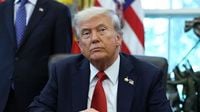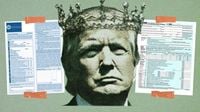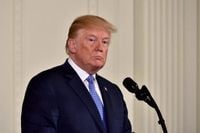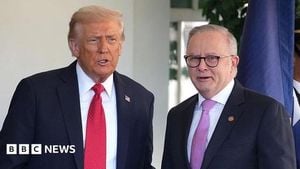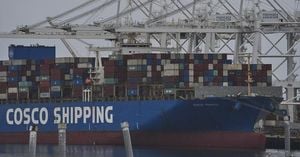Global markets surged on October 20, 2025, as investors digested a flurry of economic, legal, and political developments surrounding President Donald Trump’s sweeping tariffs, looming Supreme Court scrutiny, and shifting trade strategies. From Wall Street to Tokyo, optimism was palpable, but uncertainty still lingered as the United States approached a legal showdown that could reshape the country’s trade and economic landscape for years to come.
Stock futures in the U.S. pointed higher before the opening bell, with S&P 500 futures up 0.27%. The index had already closed up 0.53% in its last session, reflecting growing confidence among investors. According to Benzinga, the SPDR S&P 500 ETF Trust and Invesco QQQ Trust ETF, which track the S&P 500 and Nasdaq 100 respectively, posted robust year-to-date gains of 13.64% and 18.36% as of October 19, 2025. Across the Atlantic, the Stoxx 600 rose 0.63%, while the U.K.’s FTSE 100 gained 0.36%. In Asia, the Nikkei 225 soared 3.37% after the Liberal Democratic Party and Japan Innovation Party formed a coalition, making Sanae Takaichi Japan’s first female prime minister—a move widely seen as pro-stimulus. China’s CSI 300 rose 0.53% after the country reported stronger-than-expected GDP growth of 4.8% in the third quarter, according to The Wall Street Journal.
These market gains came amid a backdrop of high-stakes legal drama. The Supreme Court is set to hear arguments in November on whether President Trump’s use of the International Emergency Economic Powers Act (IEEPA) to impose duties on $2.2 trillion worth of imports was constitutional. As reported by The Washington Post and Bloomberg, small businesses and trade groups argue that Trump overstepped his authority, effectively usurping Congress’s explicit power to tax by imposing tariffs under a law never intended for that purpose. Learning Resources Inc., one of the plaintiffs, urged the justices to affirm lower court rulings that the tariffs amount to a massive illegal tax on American companies.
The heart of the legal challenge centers on whether tariffs are taxes or trade regulations. Legal scholars point to a long history—including James Madison’s writings and the Supreme Court’s 1928 ruling in J.W. Hampton v. U.S.—that recognizes tariffs as both revenue-raising measures and tools of trade regulation. Phil Magness, an economic historian at the Independent Institute, explained that "every tariff bill that Congress passed from 1789 [to today] starts with 'An act to raise revenue for the United States' or something of that nature." The current case tests whether Congress can delegate such broad taxing powers to the president, especially under the major questions doctrine, which holds that Congress may not implicitly hand over major economic or political decisions without clear statutory authority.
President Trump, for his part, has consistently defended the tariffs as vital for both U.S. revenue and diplomatic leverage. In a recent interview with Maria Bartiromo on “Sunday Morning Futures,” Trump warned that a Supreme Court ruling against most tariffs imposed this year could “literally destroy” the U.S. economy. He claimed tariffs helped bring over $17 trillion in investments to the U.S. and even credited them with ending eight wars, including the conflict between India and Pakistan. “If we don’t, we’ll be struggling for years to come,” Trump emphasized, highlighting the potential long-term impact of a negative ruling. He also warned that nullifying the tariffs could force the U.S. to unwind trade deals with the EU, Japan, and South Korea, and potentially saddle the country with "trillions and trillions of dollars" in debt.
Trump’s administration has not been idle in the face of mounting legal challenges and shifting economic winds. As The Wall Street Journal explained, the administration is rolling back tariffs on products that cannot be produced in the U.S. or in sufficient quantities, granting exemptions for dozens of items including farm goods, airplane components, drug ingredients, and essential minerals. In September, Trump signed an executive order expanding the list of exemptions and creating a framework for potential zero-tariff treatment for countries that strike new trade agreements with the U.S. These moves come as the administration negotiates with major partners like the European Union and Japan, and as the Supreme Court prepares to rule on the legality of the tariffs.
Trade analysts suggest that the administration’s retreat on some tariffs is a hedge against the possibility that the Supreme Court will require the government to refund billions in collected duties. Federal appeals courts have already ruled the tariffs illegal, but they remain in effect while the Supreme Court reviews the case. Economist Peter Schiff predicted that the tariffs would be declared unconstitutional, potentially leading to significant refunds for American importers—a scenario that would further complicate the country’s fiscal outlook.
The legal questions surrounding Trump’s use of the IEEPA are not just academic. In April 2025, Trump declared a national emergency, citing the “large and persistent annual U.S. goods trade deficits” as an “unusual and extraordinary threat to the national security and economy of the United States.” Yet critics, including Scott Lincicome of the Cato Institute, argue that the trade deficit is neither unusual nor extraordinary, noting that “they’ve been around for 30-plus years and the U.S. economy has expanded and contracted completely independent of those.” Lincicome also pointed out that there’s “a strong correlation between a rising trade deficit and [an] expanding economy,” casting doubt on the premise of the national emergency.
Meanwhile, the economic impact of the tariffs is clear. The U.S. trade deficit reached $1.06 trillion in the first seven months of 2025, putting it on track to surpass the record $1.2 trillion deficit recorded for all of 2024, according to the Bureau of Economic Analysis. The “Liberation Day” tariffs announced in April pushed the average U.S. tariff rate to its highest level since the Great Depression, before the recent rollbacks began to take effect.
Despite the turbulence, investors seem to believe that the worst-case scenario—a sudden imposition of 100% tariffs on Beijing starting November 1—is unlikely. According to Deutsche Bank’s Jim Reid, Polymarket data as of October 20 put the odds at just 7% that such tariffs would take effect by that date. There is also growing conviction that the U.S. Federal Reserve will cut interest rates next week, with ING’s Francesco Pesole telling clients he expects a 0.3% month-over-month core CPI increase for September, which should further endorse a 25 basis point rate cut.
If the Supreme Court ultimately rules against the tariffs, as many expect, about 70% of them could be lifted. Yet the administration has backup plans, including the use of Section 232 sectoral tariffs and other authorities, to try to maintain some trade barriers and cushion the economic fallout.
For now, markets are buoyant, but the stakes could hardly be higher. The coming Supreme Court decision will not only determine the fate of Trump’s tariffs but could also redefine the balance of power between Congress and the president when it comes to trade—and taxes.
